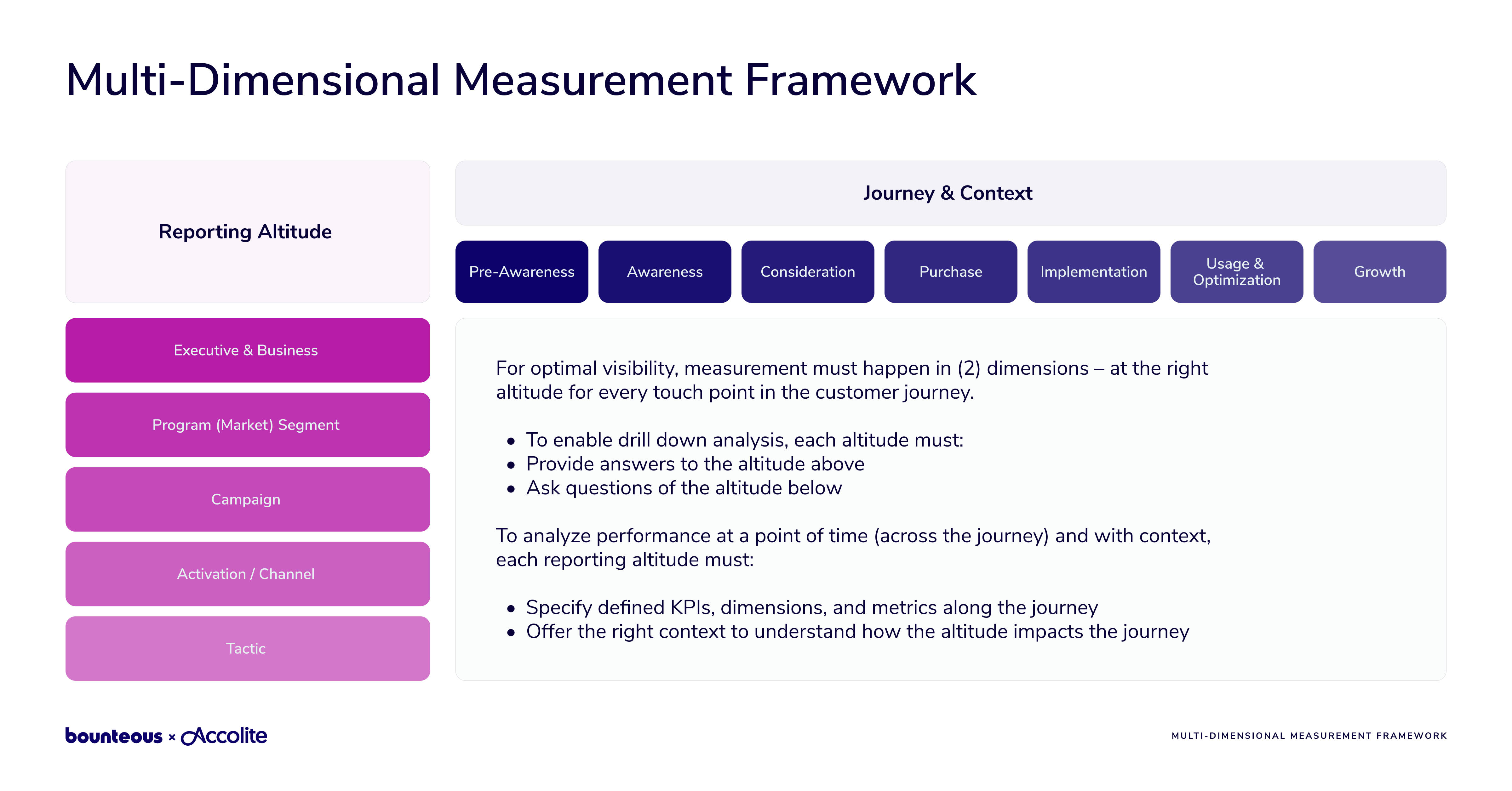Enabling B2B Performance Optimization through Measurement Strategy

For many B2B organizations, measuring and reporting on value is difficult. The length of the sales cycle, connectivity between marketing, sales, and product, and the overall deal size often mean organizations experience difficulties measuring success at critical moments in the customer lifecycle. Organizations struggle even more when asked to draw clear lines from bottom-funnel performance outcomes to top-of-funnel investments like digital advertising and SEO. In an environment where nimble, data-driven decision-making is staying competitive, enabling continuous optimization to the right metrics at the right time is key.
For many brands, sales and marketing leaders have yet to align on the right metrics or the right reporting intervals. These are questions that can be answered through the development and implementation of a comprehensive Measurement Strategy.
What is a Measurement Strategy?
Measurement is a deceptively heavy word; multidimensional and far-reaching into an organization. In short, a measurement strategy aims to identify key business questions that must be answered across the customer lifecycle, then pairs these questions with the relevant metrics required to effectively answer them. That may sound straightforward, but depending on where an organization currently sits in terms of maturity (digital and beyond), that exercise may be more challenging.
The “secret sauce” of a successful measurement strategy includes tying an organization’s performance data directly to key business questions. As business questions become more complex, additional dimensions must be included to support the reporting granularity necessary. The metrics and dimensions required to answer a question will change as they’re applied across the customer journey as well as up or down through the granularity levels. This “movement” across the X and Y axis is what we’ve come to know as a Measurement Framework. Below is a visual reference to help illustrate the concept. We’ll come back to this concept later.

A Step-Wise Approach to Measurement Growth
Although the specific needs of an organization will vary, the milestones of developing a measurement strategy shouldn’t. Regardless of the industry, product, or customer type, there will always be business questions that need to be answered and data that can be leveraged to answer them. What remains, then, is the availability and reliability of data within the organization. Gaining ground in these areas usually looks something like this:
- Identifying key business questions that need answering and their associated outcomes.
- Aligning metrics and/or data points to those questions to describe business outcomes.
- This may also involve setting (realistic, reasonable, achievable) goals for these metrics
- Understanding data architecture and tech stack configuration through the lens of measurement and identifying necessary changes to unlock data flows and availability.
- The level of effort, cost, and impact on the business will organically prioritize activities and help construct a roadmap.
- Execute against the roadmap to begin growing into a measurement strategy.
Beginning with Business Outcomes in Mind
Crafting a measurement strategy begins with understanding what the business and organization values. Consider the following examples utilizing website traffic and paid digital advertising’s effect on that performance as an example. You’ll notice a relatively exponential increase in the amount of “stitching” (data orchestration) required as the examples progress.
| Level | Question | Required Metrics | Required Dimensions | Notes |
|---|---|---|---|---|
| Basic | How much web traffic are we driving to the website monthly? | Site Visits | Date (rolled up to the month) | N/A |
| Intermediate | How much web traffic is my new ad campaign driving to the website monthly? | Site Visits | Date (rolled up to the month), Ad Campaign Name | Does this organization have the proper campaign tagging and data orchestration in place to support this use case? |
| Advanced | What is the return on investment of our programmatic media campaigns this month? | Ad Spend, Ad Clicks, Closed Won Business (dollar value), Closed Won Opportunities (count) | Ad Campaign Name, Date (rolled up to the month), Opportunity Status, Opportunity Close Date | Does this organization have the proper campaign tagging and data orchestration in place to support this use case? |
The Importance of Data Orchestration
In the examples we covered, more complex business questions require more complex data orchestration to answer. Data Orchestration can be thought of as stitching critical data points together throughout the customer lifecycle to enable reporting and analytics visibility as well as advanced activation use cases including personalization and customer-centricity.
For instance, measuring the financial effectiveness of an email-oriented marketing campaign would require tying a unique identifier (an ID) for an individual who responded to a marketing activity in the upper-to-mid funnel to a sales outcome at the bottom of the funnel. Without this connective tissue, there wouldn’t be anything to bridge the gap between funnel stages.
This connective tissue allows organizations to stretch their data across the customer journey to unlock visibility. An organization’s ability to stretch and the amount of stretching required varies greatly depending on digital maturity and the use cases at hand, respectively.
On the activation side, connectivity tends to look like enriching a consolidated data model with behavioral and interactive data to foster a 360-degree view of the customer, offering opportunities for omnichannel personalization and more nimble marketing operations. This foundation serves as an accelerator for marketing activation, audience building, and more sophisticated segmentation capabilities. As these things mature, so do the organization’s measurement needs. This symbiotic relationship is what drives iteration and maturity as the business grows.
How Does a Measurement Strategy Affect the Organization?
Those familiar with marketing operations and automation will be quick to point out that there’s a lot more to data orchestration than sitting down for some knitting — and they’d be correct. Data orchestration at this scale mandates that multiple critical business functions align against a common goal and execute. This tends to present a challenge for many organizations, often causing friction between technology owners and operators and business leadership in these areas. The only path forward is true partnership between key stakeholder teams.
In short, a measurement strategy’s success is incumbent on the organization’s ability to collaborate and work cross-functionally. We’ve seen success in aligning various business functions to a measurement strategy through lean, purposeful documentation — specifically around KPIs and their definitions. This way, varying definitions, processes, and use cases across teams are laid out clearly.
The Need For Data Centralization (and all that comes with it)
Many organizations already understand the benefits of centralizing their data. At first glance, there are obvious efficiencies across processes, technology, and personnel. However, measurement strategies are most effective when there is a consolidated warehouse acting as the foundation of both analytics and activation.
Centralizing performance data allows for a single source of truth for the definitions, and more importantly, the values for each KPI. Too often organizations find themselves reporting slightly different versions of the same story from different sources to leadership which, instead of creating visibility, creates confusion, uncertainty, and distrust across the organization. If there’s only one source, there’s only one version of the story.
This concept also holds true as Marketing teams activate their data. Audience generation, channel activation, and personalization all benefit from a streamlined and consolidated warehouse in many of the same ways. Sourcing audience attributes from the location as the data that is responsible for creating those attributes means more nimble execution on both ends.
This begins to highlight the need for a focus on both Data Quality and Data Governance with respect to data warehousing. Without proper governance processes in place, centralized data stores can quickly become untamed and lawless. Rather than fostering an environment of efficiency and growth, an unkempt warehouse is more likely to hinder it. Data sources and ingestion, ETL processes, and MDM (master data management) schemas are just a few of the critical components to success in this regard.
In the B2B space specifically, where longer sales cycles and lead qualification processes typically mandate manual intervention, governance is even more essential. If manual processes can’t be automated to mitigate the risk of human error, strict governance must be enforced to prevent mistakes that would have a significant impact on data quality.
Extending the Value of Your Measurement Strategy
Let’s say your organization has developed its Measurement Framework and stood up a KPI Matrix to support it. Now it’s time to assess how much of the framework the organization is equipped to address. Referencing the axes of the customer lifecycle and reporting granularity levels, how far and/or deep your organization can go may vary depending on the previously discussed key factors of maturity, data orchestration, technology, and process. Based on the evaluation of your organization’s capabilities, it may look something like this:
Unlocking value from a measurement strategy requires that the organization begins to mature in terms of data orchestration, centralization, governance, and analytics capability. Typically, the further a KPI sits in the customer journey from the marketing or sales activity associated with it, the more orchestration may be required to visualize it. This concept can help prioritize efforts as the organization looks to execute against a measurement strategy.
Key Outcomes of Measurement Strategy
To this point, the benefits and value adds of implementing a measurement strategy have been mostly intangible; more focused on fostering increases in digital and organizational maturity than unlocking specific pieces of analytics or activation functionality. Analytics outcomes like ROMI or multi-touch attribution are tactics afforded as byproducts of the growth mandated by a measurement strategy rather than the sole reason for the existence of the strategy.
More specifically, measurement strategies help organizations move towards an evolution of the way performance is tied to business outcomes and optimization opportunities — here’s what you should expect:
- Improved understanding of budget performance with respect to lead generation.
- Better insight into where opportunities get “stuck” along the Sales Cycle.
- Ability to set realistic, meaningful goals and forecast against them.
- Organization-wide alignment (with single KPIs)
- Opportunities for automation of reporting a single source of truth for Marketing performance.
These capabilities may sound out of reach for some brands, but they don’t have to be. A journey, no matter the distance, starts with a single step. In this case, all that’s required is the courage to ask a question and the determination to answer it.


